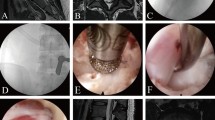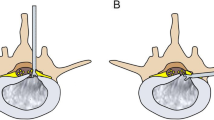Abstract
Purpose
The aim of this study was to systematically compare the safety and effectiveness of percutaneous endoscopic transforaminal discectomy (PETD) versus percutaneous endoscopic interlaminar discectomy (PEID) for the treatment of lumbar disc herniation (LDH).
Material and methods
All studies that were performed to compare PETD with PEID to treat LDH and published until 31 August 2017 were acquired through a comprehensive search in various databases. A meta-analysis was performed using the Cochrane Collaboration’s RevMan 5.3 software.
Results
A total of 13 trials with 974 cases consisting of 3 randomized controlled trials, 3 prospective studies and 7 retrospective studies were included. The results suggest that patients treated with PEID experienced more significant advantages with shorter operation time, less intraoperative blood loss and less intraoperative fluoroscopy times but more complications than those treated with PETD; however, the two operative approaches did not significantly differ in terms of LDH recurrence, hospital stay, Oswestry disability index (ODI) scores, visual analogue scale (VAS) scores, Japanese Orthopaedic Association (JOA) scores and MacNab criteria at the final follow-up.
Conclusion
Based on the results of this study, although PEID may be superior to PETD in certain ways, some of its advantages have yet to be verified and the two interventions were not significantly different in terms of relief of symptoms and functional recovery. Therefore, PEID would be recommended for treating LDH especially at L5/S1 under certain conditions but a prudent attitude is necessary to choose between the two operative approaches before a large sample and high quality randomized controlled trials have been performed.
Zusammenfassung
Zweck
Das Ziel dieser Studie war es, die Sicherheit und Wirksamkeit der perkutanen endoskopischen transforaminalen Diskektomie (PETD) zur Behandlung lumbaler Bandscheibenvorfälle („lumbar disc herniation“, LHD) systematisch zu vergleichen.
Material und Methoden
Alle Studien, die durchgeführt wurden, um die PETD mit der PEID zur Behandlung eines LDH zu vergleichen und bis 31. August 2017 veröffentlicht worden waren, wurden aus einer umfassenden Suche in verschiedenen Datenbanken extrahiert. Eine Metaanalyse wurde mittels Cochrane Collaboration’s RevMan 5.3 software durchgeführt.
Ergebnisse
Insgesamt wurden 13 Studien mit 974 Fällen, die jeweils 3 randomisierte kontrollierte, 3 prospektive und 7 retrospektive Studien beinhalten, wurden eingeschlossen. Die Ergebnisse zeigen, dass Patienten, die mit PEID behandelt wurden, mehr signifikante Vorteile durch eine kürzere Operationszeit, weniger intraoperativen Blutverlust sowie eine kürzere intraoperative Fluoroskopiedauer zeigten, allerdings auch mehr Komplikationen aufwiesen als Patienten, die mittels PETD behandelt wurden. Jedoch unterschieden sich die beiden Operationsverfahren beim letzten Follow-up nicht signifikant hinsichtlich eines erneuten Auftretens eines LDH, Hospitalisationsdauer, Oswestry-Disability-Index(ODI)-Scores, Scores der visuellen Analogskala (VAS), Japanese-Orthopaedic-Association(JOA)-Scores und MacNab-Kriterien.
Schlussfolgerung
Obwohl die PEID der PETD in mancher Hinsicht überlegen sein mag, müssen einige Vorteile auf Grundlage der Ergebnisse dieser Studie noch verifiziert werden. Die beiden Operationsverfahren unterschieden sich nicht signifikant hinsichtlich Symptomlinderung und Wiederherstellung der Funktionsfähigkeit. Daher wäre die PEID zur Behandlung von LDH unter gewissen Umständen insbesondere an L5/S1 zu empfehlen. Jedoch ist die Entscheidung für das ein oder andere Operationsverfahren mit Bedacht zu treffen, bis randomisierte kontrollierte Studien mit größeren Fallzahlen und hoher Qualität durchgeführt wurden.
















Similar content being viewed by others
Abbreviations
- CBRG:
-
Cochrane back review group
- JOA:
-
Japanese Orthopaedic Association
- LDH:
-
Lumber disc herniation
- NOQAS:
-
Newcastle Ottawa quality assessment scale
- ODI:
-
Oswestry disability index
- PEID:
-
Percutaneous endoscopic interlaminar discectomy
- PELD:
-
Percutaneous endoscopic lumbar discectomy
- PETD:
-
Percutaneous endoscopic transforaminal discectomy
- RoB:
-
Risk of bias
- TESSYS:
-
Transforaminal endoscopic spine system
- VAS:
-
Visual analogue scale
- YESS:
-
Yeung endoscopic spine system
References
Mixter W, Barr J (1934) Rupture of the intervertebral disc with involvement of the spinal canal. N Engl J Med 201:210–215
Caspar W (1977) A new surgical procedure for lumbar disc herniation causing less tissue damaging through a microsurgical approach. In: Brock M (ed) Lumbar disc adult hydrocephalus. Advances in neurosurgery, vol 4, pp 74–77
Hijikata S (1975) Percutaneous dicectomy: a new treatment method for lumbar disc herniation. J Toden Hosp 5:5–13
Akçakaya MO, Yörükoğlu AG, Aydoseli A et al (2016) Serum creatine phosphokinase levels as an indicator of muscle injury following lumbar disc surgery: comparison of fully endoscopic discectomy and microdiscectomy. Clin Neurol Neurosurg 145:74–78
Choi KC, Kim JS, Park CK (2016) Percutaneous endoscopic lumbar discectomyas analternative to openlumbar microdiscectomy for large lumbar disc herniation. Pain Physician 19(2):E291–E300
Kambin P, Sampson S (1986) Posterolateral percutaneous suction-excision of herniated lumbar intervertebral discs. Clin Orthop 207:37–43
Yeung AT, Tsou PM (2002) Posterolateral endoscopic excision for lumbar disc herniation: surgical technique, outcome, and complicationsin 307 consecutive cases. Spine 27:722–731
Hoogland T, Schubert M, Miklitz B et al (2006) Transforaminal posterolateral endoscopic discectomy with or without the combination of a low-dose chymopapain: a prospective randomized study in 280 consecutive cases. Spine 31:890–897
Ruetten S, Komp M, Merk H et al (2008) Full-endoscopic interlaminar and transforaminal lumbar discectomy versus conventional microsurgical technique: a prospective, randomized, controlled study. Spine 33:931–939
Furlan AD, Pennick V, Bombardier C (2009) Editorial board CBRG 2009 updated method guidelines for systematic reviews in the Cochrane Back Review Group. Spine 34:1929–1941
Stang A (2010) Critical evaluation of the Newcastle-Ottawa scale for the assessment of the quality of nonrandomized studies in meta-analyses. Eur J Epidemiol 25(9):603–605. https://doi.org/10.1007/s10654-010-9491-z
Higgins JP, Thompson SG (2002) Quantifying heterogeneity in a meta-analysis. Stat Med 21:1539–1558
Huang H, Yang B, Song JT (2017) Comparsion of percutaneous endoscopic treatment for L5/S1 disc hemiation via different approaches. Lab Med Clin 14(11):1651–1653 (in chinese)
Wang XW, Li YG (2016) Comparsion of percutaneous endoscopic treatment for lumbar disc herniation via different approaches. J Pract Orthop 22(6):532–533 (in chinese)
Tang XW, Chen XY, Jiang XF et al (2014) Percutaneous endoscopic treatment for lumbar disc herniation via different approaches: a clinical analysis. Chin J Neurosurg Dis Res 13(5):146–149 (in chinese)
Tian FW, Yang Q, Wang B et al (2015) Surgical approach analysis of percutaneous endoscopic lumbar discectomy. J Spinal Surg 13:342–346 (in chinese)
Nie HF, Zeng JC, Song YM et al (2016) Percutaneous endoscopic lumbar discectomy for L5-S1 disc herniation via an interlaminar approach versus a transforaminal approach. Spine 41:B30–B37
Luo Y, Ding XC, Hou WG et al (2015) Clinical effects of discectomy with transforaminal endoscopic through interlaminar approach and transforaminal approach for L5/S1 lumbar disc herniation. Med J West China 27:865–867. https://doi.org/10.3969/j.issn.1672-3511.2015.06.020 (in chinese)
Wang ZW, Guan FZ, Wang XW et al (2016) A comparison of the transforaminal versus the interlaminar approach to percutaneous endoscopic surgeries in treating lumbar disc herniation. Chin J Neurosurg 32:1214–1219 (in chinese)
Zha YY, Jin Y, Zhang SW et al (2017) Clinical effects of percutaneous endoscopic L5/S1 lumbar discectomy through transforaminai approach and interlaminar approach. Orthop Biomech Mater Clin Study 14:64–68. https://doi.org/10.3969/j.issn.1672-5972.2017.01.017 (in chinese)
Li YJ, Chen BL, Wang YF et al (2016) A comparison of the transforaminal versus the interlaminar approach to percutaneous endoscopic surgeries in treating L5/S1 lumbar disc herniation. Guangdong Med J 37:1535–1537 (in chinese)
Jiang Y, Zuo RJ, Wu L et al (2017) Surgical outcome of percutaneous endoscopic technique for highly migrated disc herniation via three different approaches. Chin J Orthop Trauma 30:100–104 (in chinese)
Xu Z, Shi L, Chu L et al (2013) Comparsion of percutaneous endoscopic via interlaminar and transforaminal approach for lumbar disc herniation. J Spinal Surg 11:97–100 (in chinese)
Liu C, Chu L, Yong HC et al (2017) Percutaneous endoscopic lumbar discectomy for highly migrated lumbar disc herniation. Pain Physician 20:E75–E84
Choi K-C, Kim J-S et al (2013) Percutaneous Endoscopic Lumbar Discectomy for L5–S1 Disc Herniation: Transforaminal versus Interlaminar Approach. Pain Physician 16:547–556
MacNab I (1971) Negative disc exploration: an analysis of the causes of nerve root involvement in sixty-eight patients. J Bone Joint Surg 53:891–903
Valls J, Ottolenghi CE, Schajowicz F et al (1948) Aspiration biopsy in diagnosis of lesions of vertebral bodies. J Am Med Assoc 136(6):376–382
Hijakata S (1989) Percutaneous nucleotomy. A new concept technique and 12 years’ experience. Clin Orthop Relat Res 238:9–23
Kambin P, Gellman H (1983) Percutaneous lateral discectomy of the lumbar spine: a preliminary report. Clin Orthop 174:127–132
Forst R, Hausmann B (1983) Nucleoplasty—a new examination technique. Arch Orthop Trauma Surg 101:219–221
Schreiber A, Suezawa Y, Leu H et al (1989) Does percutaneous nucleotomy with discoscopy replace conventional discectomy? Eight years of experience and results in treatment of herniated lumbar disc. Clin Orthop Relat Res 238:35–42
Sencer A, Yorukoglu AG, Akcakaya MO et al (2014) Fully Endoscopic Interlaminar and Transforaminal Lumbar Discectomy: Short-term Clinical Results of 163 Surgically Treated Patients. World Neurosurgery, 2014 82(5), 884–890.
Yeung AT (2000) The evolution of percutaneous spinal endoscopy and discectomy: state of the art. Mt Sinai J Med 67(4):327–332
Hoogland T, Schubert M, Miklitz B et al (2006) Transforaminal posterolateral endoscopic discectomy with or without the combination of a low-dose chymopapain: a prospective randomized study in 280 consecutive cases. Spine 31(24):E890–E897
Ruetten S, Komp M, Godolias G et al (2005) A extreme lateral access for the surgery of lumbar disc herniations inside the spinal canal using the full-endoscopic uniportal transforaminal approachtechnique and prospective results of 463 patients. Spine 30(22):2570–2578
Choi G, Kim JS, Lokhande P et al (2009) Percutaneous endoscopic lumbar discectomy by transiliac approach: a case report. Spine (Phila Pa 1976) 34:443–446
Yeung AT, Yeung CA (2007) Minimally invasive techniques for the management of lumbar disc herniation. Orthop Clin North Am 38:363–372
Kim CH, Chung CK, Woo JW et al (2012) Surgical outcome of percutaneous endoscopic interlaminar lumbar discectomy for highly migrated disc herniation. J Spinal Disord Tech 20(1):E75–E84
Yeom KS, Choi YS (2011) Full endoscopic contralateral transforaminal discectomy for distally migrated lumbar disc herniation. J Orthop Sci 16:263–269
Ahn Y, Chong-Ho K, Ho JL et al (2013) Radiation exposure to the surgeon during percutaneous endoscopic lumbar discectomy. Spine 38:617–625
Author contributions
Yongjing Huang and Jianjian Yin wrote the main manuscript text, and YinZhuang, Xueguang Liu and Shihao Du prepared the figures. Zhenzhong Sun, Yongjun Rui and Sheng Song compiled the data.
Author information
Authors and Affiliations
Corresponding authors
Ethics declarations
Conflict of interest
Y. Huang, J. Yin, Z. Sun, S. Song, Y. Zhuang, X. Liu, S. Du and Y. Rui declare that they have no competing interests.
For this article no studies with human participants or animals were performed by any of the authors. All studies performed were in accordance with the ethical standards indicated in each case.
Additional information
The authors Yongjing Huang and Jianjian Yin contributed equally to the manuscript.
Rights and permissions
About this article
Cite this article
Huang, Y., Yin, J., Sun, Z. et al. Percutaneous endoscopic lumbar discectomy for LDH via a transforaminal approach versus an interlaminar approach: a meta-analysis. Orthopäde 49, 338–349 (2020). https://doi.org/10.1007/s00132-019-03710-z
Published:
Issue Date:
DOI: https://doi.org/10.1007/s00132-019-03710-z




